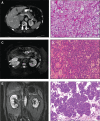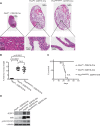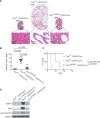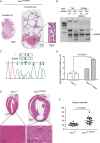H255Y and K508R missense mutations in tumour suppressor folliculin (FLCN) promote kidney cell proliferation
- PMID: 28007907
- PMCID: PMC6075457
- DOI: 10.1093/hmg/ddw392
H255Y and K508R missense mutations in tumour suppressor folliculin (FLCN) promote kidney cell proliferation
Abstract
Germline H255Y and K508R missense mutations in the folliculin (FLCN) gene have been identified in patients with bilateral multifocal (BMF) kidney tumours and clinical manifestations of Birt-Hogg-Dubé (BHD) syndrome, or with BMF kidney tumours as the only manifestation; however, their impact on FLCN function remains to be determined. In order to determine if FLCN H255Y and K508R missense mutations promote aberrant kidney cell proliferation leading to pathogenicity, we generated mouse models expressing these mutants using BAC recombineering technology and investigated their ability to rescue the multi-cystic phenotype of Flcn-deficient mouse kidneys. Flcn H255Y mutant transgene expression in kidney-targeted Flcn knockout mice did not rescue the multi-cystic kidney phenotype. However, expression of the Flcn K508R mutant transgene partially, but not completely, abrogated the phenotype. Notably, expression of the Flcn K508R mutant transgene in heterozygous Flcn knockout mice resulted in development of multi-cystic kidneys and cardiac hypertrophy in some mice. These results demonstrate that both FLCN H255Y and K508R missense mutations promote aberrant kidney cell proliferation, but to different degrees. Based on the phenotypes of our preclinical models, the FLCN H255Y mutant protein has lost it tumour suppressive function leading to the clinical manifestations of BHD, whereas the FLCN K508R mutant protein may have a dominant negative effect on the function of wild-type FLCN in regulating kidney cell proliferation and, therefore, act as an oncoprotein. These findings may provide mechanistic insight into the role of FLCN in regulating kidney cell proliferation and facilitate the development of novel therapeutics for FLCN-deficient kidney cancer.
Published by Oxford University Press 2016. This work is written by US Government employees and is in the public domain in the US.
Figures






Similar articles
-
Folliculin-interacting proteins Fnip1 and Fnip2 play critical roles in kidney tumor suppression in cooperation with Flcn.Proc Natl Acad Sci U S A. 2015 Mar 31;112(13):E1624-31. doi: 10.1073/pnas.1419502112. Epub 2015 Mar 16. Proc Natl Acad Sci U S A. 2015. PMID: 25775561 Free PMC article.
-
Renal tumour suppressor function of the Birt-Hogg-Dubé syndrome gene product folliculin.J Med Genet. 2010 Mar;47(3):182-9. doi: 10.1136/jmg.2009.072009. Epub 2009 Oct 19. J Med Genet. 2010. PMID: 19843504
-
Birt-Hogg-Dubé syndrome: Clinical and molecular aspects of recently identified kidney cancer syndrome.Int J Urol. 2016 Mar;23(3):204-10. doi: 10.1111/iju.13015. Epub 2015 Nov 25. Int J Urol. 2016. PMID: 26608100 Review.
-
Heterozygous germline FLCN mutation in Birt-Hogg-Dubé syndrome with bilateral renal hybrid oncocytic/chromophobe tumor and unilateral renal chromophobe cell carcinoma: a case report.J Cancer Res Clin Oncol. 2023 Jun;149(6):2319-2325. doi: 10.1007/s00432-022-04417-z. Epub 2022 Oct 18. J Cancer Res Clin Oncol. 2023. PMID: 36258004 Free PMC article.
-
Birt-Hogg-Dube syndrome: clinicopathological features of the lung.J Clin Pathol. 2013 Mar;66(3):178-86. doi: 10.1136/jclinpath-2012-201200. Epub 2012 Dec 8. J Clin Pathol. 2013. PMID: 23223565 Free PMC article. Review.
Cited by
-
Genetic Alterations in Renal Cancers: Identification of The Mechanisms Underlying Cancer Initiation and Progression and of Therapeutic Targets.Medicines (Basel). 2020 Jul 29;7(8):44. doi: 10.3390/medicines7080044. Medicines (Basel). 2020. PMID: 32751108 Free PMC article. Review.
-
Hybrid Oncocytic Tumors (HOTs) in Birt-Hogg-Dubé Syndrome Patients-A Tale of Two Cities: Sequencing Analysis Reveals Dual Lineage Markers Capturing the 2 Cellular Populations of HOT.Am J Surg Pathol. 2024 Feb 1;48(2):163-173. doi: 10.1097/PAS.0000000000002152. Epub 2023 Nov 24. Am J Surg Pathol. 2024. PMID: 37994665 Free PMC article.
-
Matching clinical and genetic diagnoses in autosomal dominant polycystic kidney disease reveals novel phenocopies and potential candidate genes.Genet Med. 2020 Aug;22(8):1374-1383. doi: 10.1038/s41436-020-0816-3. Epub 2020 May 13. Genet Med. 2020. PMID: 32398770 Free PMC article.
-
Seventh BHD international symposium: recent scientific and clinical advancement.Oncotarget. 2022 Jan 20;13:173-181. doi: 10.18632/oncotarget.28176. eCollection 2022. Oncotarget. 2022. PMID: 35070081 Free PMC article.
-
Hereditary kidney cancer syndromes: Genetic disorders driven by alterations in metabolism and epigenome regulation.Cancer Sci. 2018 Mar;109(3):581-586. doi: 10.1111/cas.13503. Epub 2018 Feb 15. Cancer Sci. 2018. PMID: 29325224 Free PMC article. Review.
References
-
- Birt A. R., Hogg G. R., Dube W. J. (1977) Hereditary multiple fibrofolliculomas with trichodiscomas and acrochordons. Arch. Dermatol., 113, 1674–1677. - PubMed
-
- Zbar B., Alvord W.G., Glenn G., Turner M., Pavlovich C.P., Schmidt L., McClellan W., Choyke P., Weirich G., Hewitt S. M., et al. (2002) Risk of renal and colonic neoplasms and spontaneous pneumothorax in the Birt-Hogg-Dube syndrome. Cancer Epidemiol. Biomarkers Prev ., 11, 393–400. - PubMed
-
- Nickerson M. L., Warren M.B., Toro J.R., Matrosova V., Glenn G., Turner M.L., Duray P., Merino M., Choyke P., Pavlovich C.P., et al. (2002) Mutations in a novel gene lead to kidney tumors, lung wall defects, and benign tumors of the hair follicle in patients with the Birt-Hogg-Dube syndrome. Cancer Cell, 2, 157–164. - PubMed
-
- Baba M., Hong S.B., Sharma N., Warren M.B., Nickerson M.L., Iwamatsu A., Esposito D., Gillette W.K., Hopkins R.F. III, Hartley J.L., et al. (2006) Folliculin encoded by the BHD gene interacts with a binding protein, FNIP1, and AMPK, and is involved in AMPK and mTOR signaling. Proc. Natl. Acad. Sci. USA, 103, 15552–15557. - PMC - PubMed
Publication types
MeSH terms
Substances
Grants and funding
LinkOut - more resources
Full Text Sources
Other Literature Sources
Medical
Molecular Biology Databases

